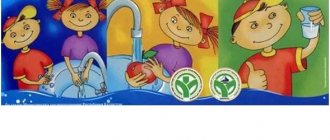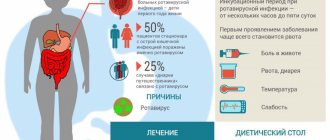general information
Constipation (constipation) is not an independent disease.
The problem is characteristic of intestinal dysfunction, which results in the inability to adequately clear it from feces. The child's bowel movements become less frequent (usually less than once every 2 days) or stop completely. Constipation occurs quite often in children, especially at the stage when the child is just starting to go to kindergarten (psychological etiology of constipation). It is important to recognize it early and begin appropriate treatment.
Symptoms
A child after 2 years of age can tell or show 3, 4 parents that he cannot go to the toilet or is in pain. But recognizing constipation in an infant aged 1.5 - 2 years is not so easy3, 4, 5.
In the case of infants, doctors recommend focusing not on the frequency of stool, which varies greatly among infants3,4, but on the density of feces and the baby’s behavior during bowel movements1,4.
If he does not cry during bowel movements, the feces pass softly, have a characteristic appearance and color1, 4, and the tummy does not become dense, as if inflated, then it is considered that the baby does not have constipation, even if he soils his diaper 2 times a week1, 4.
You can talk about probable constipation in a baby if the stool becomes denser, thicker, darker than usual 1, 4. Children under one year of age often have a swollen tummy, when pressing on it they cry or whine, and at the moment of stool expulsion they can tense up and scream 14.
After a year and older, the following are considered signs of insufficient bowel movements:
- The child began to go to the toilet “mostly” less often than before1, 3, 4.
- During defecation, it is clear that he is in pain, he has to strain 1, 3, 4.
- Passing less stool than usual1, 3, 4.
- How does it look dry, hard, dense1, 3, 4.
If the child has already had stool retention before, and he remembers5 that it hurts, then he begins to bring his legs and knees together, walk on his heels, tuck his buttocks, hold his breath for a short time - wait it out and suppress the urge. During defecation, it is clear that the process is difficult, and to facilitate it one has to take different positions3, make significant efforts, push2, actively work with the anterior abdominal wall1, 4.
If a child has one or more signs of constipation 2-3 times within 2 months1, 6, then you need to monitor the nature and frequency of stool, and if suspicions are confirmed, then consult a doctor to find a way to help your child with constipation, select a diet and treatment1, 3.
The table below provides information 4 about approximately how many times children of different ages can have bowel movements, as well as the characteristics of stool.
| Age | How many times a day do you have stool? | Color and consistency of stool |
| 0-3 months, breastfeeding | From 1 to 5-6 times, sometimes up to 1 time every 4-7 days | Viscous, similar to semi-liquid porridge. Color - yellow, yellowish-green, golden yellow, usually uniform or with white lumps. |
| 0-3 months, artificial feeding | 1 to 4 times | Pasty. Color ranges from yellow to light brown. |
| 6-12 months | 1-3 times | Soft, shaped or pasty, brown, light brown or dark yellow, brownish-greenish. |
| 1-3 years | 1-2 times | Decorated, brown. |
| Over 3 years old | 1 time a day or at least 3 times a week | Decorated, brown, dark brown. |
Up to contents
Classification: types of constipation in children
Constipation is most often a consequence of diseases of the gastrointestinal tract (GIT). The problem is based on impaired peristalsis. Depending on the nature of this dysfunction, constipation can be:
- spastic (hypertensive), when there is too much contraction of the intestinal muscles with the impossibility of further movement of feces out;
- atonic (hypotonic), when the intestinal wall is completely relaxed and cannot contract to remove food debris from the body.
Depending on the origin, the following forms of constipation are distinguished:
- primary: associated with congenital pathologies of intestinal development;
- secondary: occurs against the background of diseases, injuries, toxins, etc.;
- idiopathic: associated with poor diet and other external causes.
Features of the course allow us to distinguish between acute and chronic constipation (the condition lasts 3 months or more).
There is also a division of childhood constipation according to the degree of compensation, which is very important for prescribing the correct treatment:
- compensation: the intestines are emptied once every 2-3 days, there is no pain or other symptoms; when correcting the diet, the problem disappears;
- subcompensation: defecation occurs once every 3-7 days and only while taking laxatives; accompanied by abdominal pain, bloating;
- decompensation: bowel movements occur less than once a week, the condition is accompanied by pain, bloating, and intoxication; Constipation can only be eliminated with an enema.
How is therapy carried out?
In the treatment of constipation, it is necessary to follow an integrated approach. Treatment is prescribed in each specific case individually, depending on the cause of constipation.
To ensure the normal functioning of all organs, it is necessary to regulate bowel movements in children. You will need to adjust your diet and lifestyle; you should not abuse laxatives, as they only help temporarily.
The basic principles of therapy include:
- Diet correction. It is necessary to eliminate foods that can cause constipation. Among them are fermented milk products, rice, baked goods, bakery products, and pasta. It is recommended to include vegetable fiber in the menu, which is found in fresh fruits and vegetables. You should also avoid fast carbohydrates – flour products, sweets. It is necessary to add to the menu more products that contain potassium, for example, figs, dried apricots, prunes.
- Maintain drinking regime. It is important to drink clean drinking water. During the day, the child should drink at least 40 milliliters of water per kilogram of his body weight.
- As prescribed by the doctor, you need to give the baby medications and homeopathic remedies. These include medications for the outflow of bile, drugs that restore intestinal microflora. You can use anthelmintics, laxatives, and medications containing lactulose. The doctor may also prescribe medications that contain polyethylene glycol. They retain moisture in the intestines and thin the stool.
- In case of prolonged constipation, the child can be given a glycerin suppository or a microenema as a stimulant.
- Undergo physiotherapy procedures prescribed by the doctor, massage, and do therapeutic exercises.
- Provide a calm environment, help the baby psychologically so that he is not afraid to empty his bowels. You can read fairy tales and play with your child.
- Train the intestines, after eating, sit the child on the potty for a few minutes.
First you need to get rid of constipation and only then potty train. If constipation is not treated promptly, this will lead to unpleasant consequences for the child’s health.
Symptoms of constipation in children
Constipation itself is an isolated symptom that can accompany a number of gastrointestinal diseases.
Depending on the etiology, the accompanying clinical picture may vary. The key characteristics of constipation are a decrease in the number of bowel movements to 2 times a week or their complete absence, and a feeling of incomplete bowel movement.
Additional signs are:
- abdominal pain - the nature depends on the type of damage to the intestinal wall, while the child may feel both constant aching pain and short-term cramping attacks;
- nausea, flatulence, vomiting;
- loss of appetite, weight loss;
- slight increase in body temperature.
If the cause of constipation in a child is surgical pathology, then the clinical picture may also include fever, general weakness, fatigue, and severe pain in the anterior abdominal wall.
If there are signs of constipation, parents should consult a doctor with their child. If constipation becomes chronic, children become irritable, sleep poorly, are capricious, and their appetite suffers. Against the background of impaired intestinal functionality, deterioration in the quality of hair, skin and nails may occur.
Causes of constipation in children
The pathogenetic basis for the development of constipation is a dysfunction of the muscular lining of the intestine with a deterioration in its peristalsis. The causes may include infectious diseases provoked by a specific pathogen, as well as exacerbations of pathologies of other organs and systems, as well as other external and internal factors.
- Poor nutrition. If the baby from the first days receives heavy food containing a lot of protein, then there is every chance of rapid development of constipation. For infants, in order to prevent bowel disorders, it is very important to try to maintain breastfeeding. Artificial mixtures increase the risk of developing constipation.
- Lack of water in the body. If a child drinks little, then the stool in the intestines becomes hard and is difficult to remove from the body.
- Side effect of certain medications. Antibiotics can negatively affect the intestinal microflora.
- Psychological aspects. Sometimes in children, against the background of psychoemotional stress, intestinal motility slows down and the act of defecation is consciously suppressed. So, not every child goes to the toilet at a party, cafe or kindergarten.
- Anomalies in the development of the digestive tract. With congenital defects, even a newborn may experience constipation associated with a primary disorder of intestinal function.
Chronic diseases of other organs and systems also provoke a slowdown or acceleration of peristalsis.
Remedies for treating constipation, simple and difficult
A nursing mother should eat fruit.
To eliminate the cause of fluid deficiency, the child is given water.
A nursing mother should eat foods such as prunes, dried apricots, beets, figs, apricots, peaches, apples, exclude baked goods, rich broths, coffee and tea and others that negatively affect the composition of milk, including bananas and nuts. .
It is easy to select an unsuitable mixture for feeding with the modern range of mixtures of this kind. The same applies to inappropriate complementary foods that require replacement. Replace the medicine with an analogue that does not have similar negative effects.
Try to eliminate the lack of milk with the help of appropriate food, pumping or lactostimulants. The last two reasons require undoubted medical intervention, and hereditary pathologies and diseases require long-term and serious intervention.
Diagnostics
SM-Doctor is an advanced medical center specializing in the diagnosis and treatment of gastrointestinal diseases. Modern equipment and highly qualified personnel help to quickly diagnose the causes and mechanism of constipation in a child.
The specialist determines the presence of defecation disorders for a specific age at the stage of conversation with the patient or parents. To confirm the diagnosis, the following examinations may be prescribed:
- general blood and urine analysis;
- blood chemistry;
- feces on helminth eggs;
- Ultrasound of the abdominal organs;
- irrigography is an x-ray method that is used if there is a suspicion of intestinal obstruction;
- colonoscopy;
- CT/MRI of the abdominal cavity.
If necessary, the doctor refers the child to consultations with related specialists. This approach allows you to comprehensively solve the problem of constipation and prevent its occurrence in the future.
Treatment of constipation
Treatment of constipation in children of different ages is aimed at improving intestinal motility and facilitating its release from feces. To achieve these goals, at the first stage, non-drug methods are used, namely lifestyle modification:
- normalization of nutrition with an increase in the amount of vegetables and fruits in the daily diet;
- increasing the volume of fluid consumed;
- refusal of “heavy” foods (fast food, large amounts of meat, sweets).
Taking laxatives in children is not advisable. On the one hand, this is associated with the risk of developing side effects, and on the other hand, there is a possibility of addiction. Therefore, it is so important to identify the cause of constipation and act on it. However, there are groups of drugs that are used at the first stage to normalize the passage of feces through the intestines. These are drugs that increase the volume of feces - they act after about 24 hours; and “quick response” drugs (for example, glycerin suppositories), which accelerate peristalsis, the effect develops in 10-15 minutes.
Diarrhea and constipation as two worrying factors
Constipation is an unpleasant phenomenon for both adults and children.
Diarrhea and constipation are two equally unpleasant and disturbing phenomena even in adulthood, when the digestive system is sufficiently developed.
In infancy, this is not necessarily a reason to take medications, but in any case a reason to find out and eliminate the cause.
A thorough analysis of the components of breast milk, the mother’s refusal of foods that could cause such phenomena, simple folk remedies in the form of her consumption of corrective substances.
They are completely different for constipation and diarrhea. Unformed stool is normal for a child due to the monotony of food intake. Constipation is much more serious in etiology.
Lack of stool for a certain period of time is not always a sign of constipation. Many mothers, especially those who do not have relevant experience, begin to sound the alarm at the first missed bowel movement. But a temporary lack of stool is not always constipation.
Prevention of constipation in children
Prevention of constipation is based on a balanced diet, sufficient fluid intake and timely treatment of other gastrointestinal diseases.
“SM-Doctor” is a clinic where every child experiencing constipation is provided with a full range of services to identify and treat primary pathology of any origin. Our own laboratory, modern equipment and highly qualified personnel will help solve this problem. Contact professionals so that your baby can feel the ease of liberation!
Main reasons
Why is there constant constipation in one-year-old children or a six-month-old toddler? The main causes of constipation in babies include:
- poor nutrition, namely an abundance of fatty, sour, smoked and salty foods in the diet;
- low activity level of the baby;
- the presence of anal fissures, hemorrhoids, which cause pain during bowel movements;
- high workload of the child and exposure to stress;
- taking antihistamines, antidepressants, codeine, diuretics;
- presence of helminthic infestation;
- allergy to the abundance of protein foods in the diet;
- dysbacteriosis, which often alternates with constipation;
- heredity.









